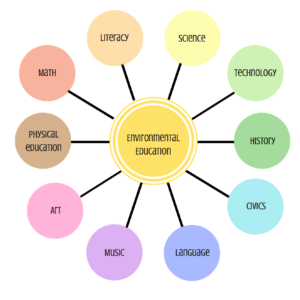 Our children spend more time indoors than ever before. They are disconnected from nature and the joy that comes from exploring their community. The effects of “nature deficit disorder” are reflected in increasing child obesity rates and declining academic scores.
Our children spend more time indoors than ever before. They are disconnected from nature and the joy that comes from exploring their community. The effects of “nature deficit disorder” are reflected in increasing child obesity rates and declining academic scores.
How do we define outdoor and environmental learning?
After a two-year community-centered process where we engaged over 200 individuals representing 90 school, agencies, and organizations (https://eenm.org/about/), we adopted a new framing valuing the many different approaches to outdoor and environmental learning. A broader definition is reflected in our name change (to EENM) as well as our branding which now includes a plus sign to represent our commitment to supporting the many valuable ways our kids can engage in the outdoors and environmental learning. This community-generated definition includes, but is not limited to conservation, experiential, environmental, land-based, nature-based, outdoor, and place-based education and learning. We value education and learning that is student-centered, culturally relevant and responsive, relevant and meaningful, multidisciplinary, and supports physical, emotional, social, and spiritual health and wellbeing.
More about environmental education:
Environmental education engages learners as they understand how nature works and how humans impact our world. EE is hands-on, interdisciplinary, empowering, and relevant to learners’ everyday lives. It gives them the knowledge and tools they need to be environmentally literate–ready to face environmental and social challenges with confidence and optimism.
Benefits for academics, relationships, and life
There is mounting evidence on the widespread benefits of environmental education, including positive impacts on academic performance, motivation and interest in school, social and emotional skills, and civic interest and engagement.1
Environmental education is a win-win–it’s good for our environment and it’s good for kids.

Environmental education for all students
EENM believes that access to environmental and place-based learning is an issue of equity, and is committed to the idea that all students deserve authentic, relevant, and meaningful learning opportunities. To this end, we support multidisciplinary and student-centered environmental education that is responsive to the needs of teachers, students, and communities.
Environmental education helps us to understand the world around us. This understanding can be facilitated through work in virtually any subject area, including science, math, technology, literacy, history, civics, language, physical education, music, art, and more. Good environmental education helps students see the connections between disciplines and apply knowledge in flexible, adaptive ways.
All students deserve to see themselves in their education and to have learning opportunities that suit them as individuals. Our vision is environmental education that is tailored to fit students of varying ages, abilities, developmental levels, English proficiency, learning styles, and cultural backgrounds.
Citations:
- Ardoin, Bowers, Roth, & Holthuis, 2016.

